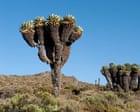The common groundsel is a weedy plant often seen on waste ground and roadsides, growing up to about 40cm (16in) tall. But on mountains in east Africa relatives of the groundsel can grow up to 9 metres (30ft) in height. One of these giant groundsels isDendrosenecio kilimanjari, which only grows high up on Mount Kilimanjaro in Tanzania and looks like something from another world –a woody trunkthat can branch out like a candelabra, sprouting a large inflorescence atop each branch.
Other Dendrosenecio species grow on other mountains, all superbly adapted to the harsh upland environments where temperatures can plunge as low as -20C (-4F) in biting winds. Their thick stems are insulated by jackets of dead and withered leaves, they use an antifreeze agent to prevent ice forming in their tissues, and at night their leaves “sleep”, folding up to help keep the plant warm. Rainfall can be scarce and the giant groundsels store water in the pith of their stems. As a result of their spartan existence, they can grow extremely slowly.
